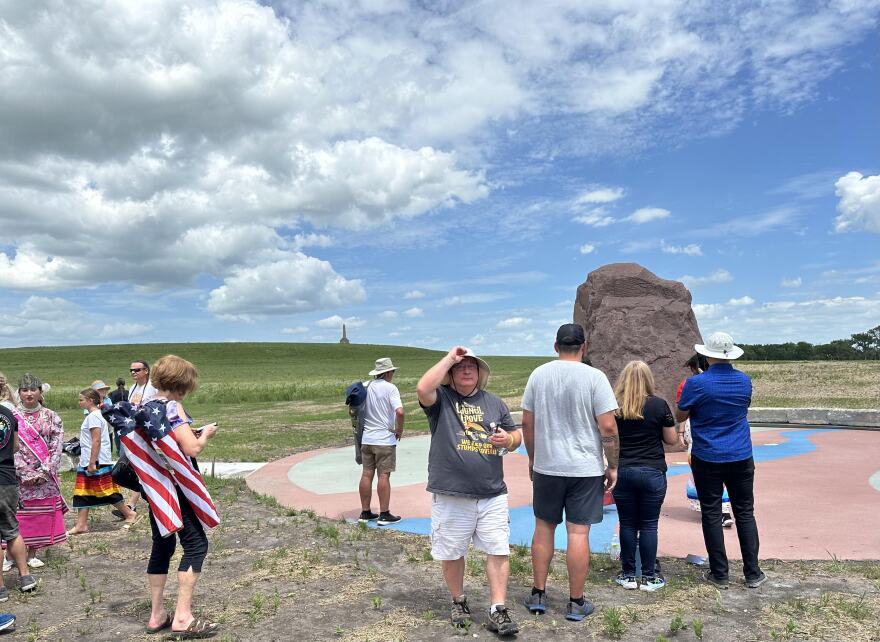On Saturday, about 300 people crowded under and around a big white canopy in the Flint Hills outside Council Grove, Kansas as the sun blazed down. They gathered from around the country to celebrate a pair of journeys that brought a huge rock and a proud tribe together to Allegawaho Memorial Heritage Park.
“Today, we welcome home our grandfather Íⁿ'zhúje'waxóbe to our Kaw Nation lands and the last reservation we had in Kansas,” said James Pepper Henry, vice-chair of the Kaw Nation Tribal Council.
The tribe, known then as the Kanza, revered the huge red boulder for hundreds of years before European settlers showed up. When the federal government forced the Kaw people off their land, they had to leave it behind.
Now, the Kaw people have their sacred red rock back, and some hope it could help launch a resurgence of the tribe in Kansas.
About 20,000 Kaw once ranged across most of present-day Kansas. In 1873, the federal government banished the last sick and starving Kaw from the last of the 22 million acres they controlled in Kansas under an 1825 treaty to a five-acre cemetery in Oklahoma. The tribe’s population shrank to about 180, and almost died out entirely.
“Smallpox, other diseases brought by settlers, other tribes encroaching, being pushed from the east to the west... a lot of factors went into our population being decimated,” said Pepper Henry.

The rock they held sacred was pushed around, too. Hundreds of thousands of years ago, a glacier tore it out of bedrock and bulldozed it hundreds of miles south before dropping on the bank of what’s now called the Kaw or Kansas River, between Topeka and Lawrence. It was a landmark for white settlers, lodged at the confluence of the Kansas River and Shunganunga Creek.
Civic boosters from both Lawrence and Topeka conspired to cart it off as a prize. Lawrence got there first, and in 1929 set the stone up in a tiny park overlooking the river as a tribute to the abolitionist founders of the city.
Pepper Henry told the city council decades ago that it was sacred to the Kaw people, but it was now a part of Lawrence, too — and, at about 28 tons, not easy to move. Then, about seven years ago, a movement to move it grew.
“How do you move a 28-ton stone? With a story, that’s how you move it,” said Dave Loewenstein, a Lawrence artist and activist.
Loewenstein began working with tribal member Pauline Sharp and Jay Johnson, who directs the Center for Indigenous Research, Science, and Technology at KU.
“The real turning point for the project was during COVID,” said Loewenstein. “Across the United States, and across the world, people started to think about the relevance of the monuments in the places that they lived.”
In 2020, the Mellon Foundation launched its Monuments Project to fund commemorations that have been left out of public history. Loewenstein brought the rock to the foundation’s attention, and the resulting $5 million grant took care of moving the stone and paying for a new visitors center, restrooms and an interactive trail on the Kaw tribe’s 160-acre Allegawaho Memorial Heritage Park.

The tribe bought the parkland two decades ago. It’s just east of Council Grove, on the Flint Hills Nature Trail. A century-old limestone obelisk monument to a Kaw warrior dominates a hillside, ruins of the last Kaw reservation in Kansas crumble on the flats and the sacred stone — now standing bolt upright — anchors the park. Kaw member Brittany Dias drove up from Tulsa, Oklahoma to see it.
“This is a really a monumental moment for us to have the sacred rock returned and brought here where it can rest, finally, and be back with its people,” said Dias.
Dias brought her young son along. Like many people at the dedication, she posed for pictures with the stone and snapped photos for other families doing the same thing.
“This isn’t just a win for the Kaw people. This is a win for everyone in Indian Country and the Indigenous communities globally,” said Dias. “We can look at it as a sense of closure, as we have closed out this understanding and idea of a colonial mentality, where we just, we take, and now we’re opening a new chapter where we are rematriating,” Dias said.
The next chapter could be repopulating. The people who gave their name to Kansas have just a tiny presence in the state. Most still live in Oklahoma. Pepper Henry hopes the rock, and the cultural heritage park they’re developing around it, will help reestablish the Kaw tribe in its native homeland.
“We’re determined to not only survive but thrive,” said Pepper Henry. “And we’re never going to let what happened to us 100 years ago, 150 years ago, that’s not going to ever happen again.”




